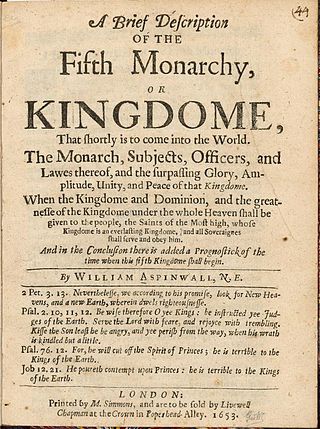
The Fifth Monarchists, or Fifth Monarchy Men, were a Protestant sect with Millennialist views, active during the 1649 to 1660 Commonwealth of England. The group took its name from a prophecy that claimed the four kingdoms of Daniel would precede the Fifth, which would see the establishment of the Kingship and kingdom of God on earth.

The Stuart Restoration was the reinstatement in May 1660 of the Stuart monarchy in England, Scotland, and Ireland. It replaced the Commonwealth of England, established in January 1649 after the execution of Charles I, with his son Charles II.

Hadley is a town in Hampshire County, Massachusetts, United States. The population was 5,325 at the 2020 census. It is part of the Springfield, Massachusetts Metropolitan Statistical Area. The area around the Hampshire and Mountain Farms Malls along Route 9 is a major shopping destination for the surrounding communities.
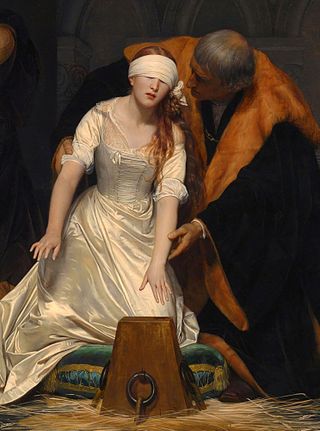
Regicide is the purposeful killing of a monarch or sovereign of a polity and is often associated with the usurpation of power. A regicide can also be the person responsible for the killing. The word comes from the Latin roots of regis and cida (cidium), meaning "of monarch" and "killer" respectively.
Edward Whalley was an English military leader during the English Civil War and was one of the regicides who signed the death warrant of King Charles I of England.

William Goffe, c. 1613/1618 - 1679/1680, was an English soldier from London who fought for Parliament during the Wars of the Three Kingdoms. A religious radical nicknamed “Praying William” by contemporaries, he approved the Execution of Charles I in January 1649, but escaped prosecution as a regicide by fleeing to New England.

New Haven Colony was an English colony from 1638 to 1664 that included settlements on the north shore of Long Island Sound, with outposts in modern-day New York, New Jersey, Pennsylvania, and Delaware. The colony joined Connecticut Colony in 1664.
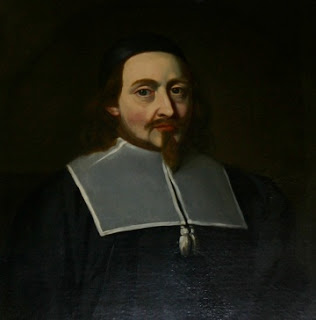
John Endecott, regarded as one of the Fathers of New England, was the longest-serving governor of the Massachusetts Bay Colony, which became the Commonwealth of Massachusetts. He served a total of 16 years, including most of the last 15 years of his life. When not serving as governor, he was involved in other elected and appointed positions from 1628 to 1665 except for the single year of 1634.

John Dixwell, alias James Davids, was an English lawyer, republican politician and regicide. Born in Warwickshire, during the Wars of the Three Kingdoms he held various administrative positions in Kent on behalf of Parliament, and approved the Execution of Charles I in January 1649. Under the Commonwealth, he served as Governor of Dover Castle, and was a member of the English Council of State.

Regicides Trail is a Blue-Blazed hiking trail, about 7 miles (11 km) long, roughly following the edge of a diabase, or traprock, cliff northwest of New Haven, Connecticut. It is named for two regicides, Edward Whalley and his son-in-law William Goffe, who signed the death warrant of King Charles I of England. Upon the restoration of Charles II to the throne and the persecution of the regicides, the pair hid in Judges Cave near the south end of the trail in 1660. The Regicides is widely known to be one of the most technical trails within the CT Blue-Blazed trail system.
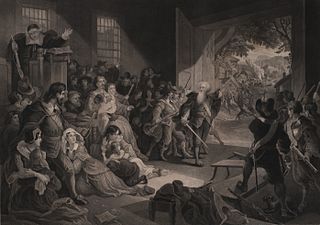
The Angel of Hadley is the central character in a possibly apocryphal tale combining the execution of Charles I in England, King Philip's War and Hadley, Massachusetts. According to the tale Colonel William Goffe, who was wanted for his role in the regicide, was hiding in Hadley when it was attacked by Indians in 1675 or 1676. Goffe, by then an aging figure, is said to have come out of his hiding to lead the local residents in the successful defense of their community against the attack.
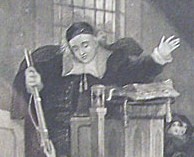
John Russell was a Puritan minister in Hadley, Massachusetts, during King Philip's War. As such, he is part of the Angel of Hadley legend.
James Temple was a puritan and English Civil War soldier who was convicted of the regicide of Charles I. Born in Rochester, Kent, to a well-connected gentry family, he was the second of two sons of Sir Alexander Temple, although his elder brother died in 1627. As a child, Temple moved with his father from Rochester to Chadwell St Mary in Essex and then to Etchingham in Sussex, where he settled.
Events from the year 1660 in England. This is the year of the Stuart Restoration.

West Rock Ridge State Park is a public recreation area located in New Haven, Hamden, and Woodbridge, Connecticut. The state park is named for the 400-to-700-foot trap rock West Rock Ridge, which is part of the Metacomet Ridge extending from Long Island Sound to the Vermont border. The park's 7 miles (11 km) of open west-facing cliffs offer vistas encompassing Metropolitan New Haven and suburban towns to the west. The park includes Judges Cave, a colonial era historic site; Lake Wintergreen; and the 7-mile (11 km) Regicides Trail, part of the Connecticut Forest and Park Association's Blue Trail system. The park is part of a larger area of protected open space including state, municipal, and non-profit owned land.
William Leete was Governor of the Colony of New Haven from 1661 to 1665 and Governor of the Colony of Connecticut from 1676 to 1683.
The Restoration of the monarchy began in 1660 when the English, Scottish and Irish monarchies were all restored under Charles II after the republic that followed the Wars of the Three Kingdoms. The term Restoration may apply both to the actual event by which the monarchy was restored, and to the period immediately following the event.

William Jones was an English lawyer who emigrated to the United Colonies of New England and became the twenty-fourth Deputy Governor of the Colony of Connecticut. He notably hosted at his home the regicides Whalley and Goffe, family members of Oliver Cromwell.











